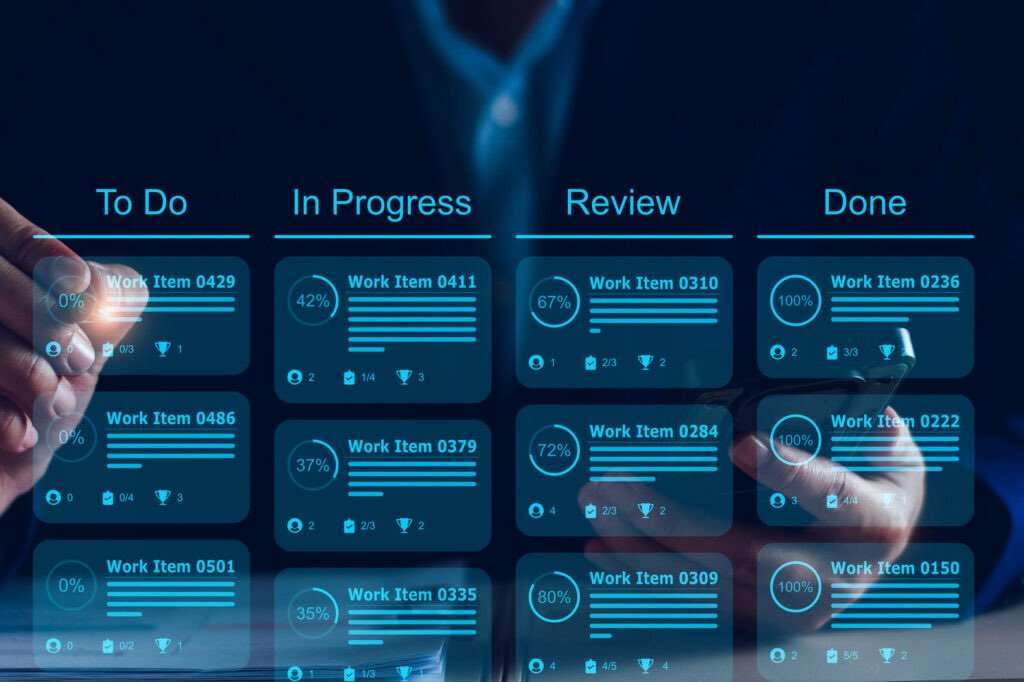In the modern business world, where speed and efficiency are key, managers are often looking for ways to ‘push’ their teams to perform better. But what if working harder is not the solution? What if the key to higher productivity lies in optimising the flow of work? This is where Kanban comes into play. Kanban is more than just a “team tool”. – Higher management levels such as portfolio management can also benefit significantly from Kanban.
Kanban: More than just a team tool
Kanban is widely known as a method to improve the efficiency of teams by visualising the flow of work and identifying bottlenecks. But Kanban can also play an important role at portfolio level. For example, Kanban helps to visualize and optimize the entire value stream of a company and ensure that the right projects are advanced at the right time.
–

The focus is on flow
One of the Kanban principles is: “Manage Flow”.
In the context of Kanban, “flow” refers to the smooth and continuous progress of work tasks through various process stages. An astonishing fact is that in many organizations only about 15% of throughput time is actually used for processing requests. The remaining time is lost to waiting times, bottlenecks and other inefficiencies. This is where Kanban comes in, by making these bottlenecks visible and thus facilitating measures to improve flow. Improving flow, in turn, supports smooth and predictable flow and delivery.
Kanban in portfolio management
At the portfolio level, Kanban helps to create a clear overview of all current and planned projects. This enables management to make informed decisions about priorities and resource allocations. Important aspects here are
- Creating transparency: A Kanban board at portfolio level visualises the status of all projects and makes bottlenecks visible. This makes it easier to identify and address problems at an early stage.
- Optimizing lead times: Bottlenecks can be reduced by introducing WIP limits (work in progress limits) and continuously monitoring and adjusting the flow. By reducing bottlenecks, throughput times can then be shortened overall. This makes it possible to generate added value for customers more quickly.
- Continuous improvement: Regularly reviewing and adapting working methods promotes a culture of continuous improvement. This involves teams and managers working together to continuously optimise the workflow and increase efficiency.
Link Kanban at different levels. Prevent local optimisation. Strengthen delivery capability.
There is always a risk of local optimization in the context of improvements. This risk can be minimized by considering the entire value chain. For the use of Kanban, this can mean, among other things, using Kanban across several levels.
The parallel use of Kanban at several levels – from individual teams to team clusters to the portfolio level – enables work to be synchronised and controlled. and thus a better basis for decision-making, but ultimately also an improvement in delivery capability.
Advantages of Kanban at all management levels
At management level, all these benefits are complemented by support for fast and well-founded decision-making based on real-time data and visualisations.
Frameworks such as SAFe® also use Kanban at various levels, including at portfolio level.
Conclusion
Kanban is not only a tool for teams, but also a powerful tool for (portfolio) management. By focusing on flow, Kanban helps to increase efficiency and productivity at all levels of an organization. If working harder is not the solution, then the problem is probably not that people are working too little, but rather inefficient processes. Kanban offers a structured method to optimise these processes and thus pave the way for a sustainable improvement in company performance.
What does improving delivery capability mean to you and how can we support your company?
Feel free to contact us …
You can also take a look at our website, for example on the topics of leadership development,corporate strategy and portfolio management or our training courses, for example our certified Kanban training courses.
If you have any questions or suggestions…
Feel free to contact us.